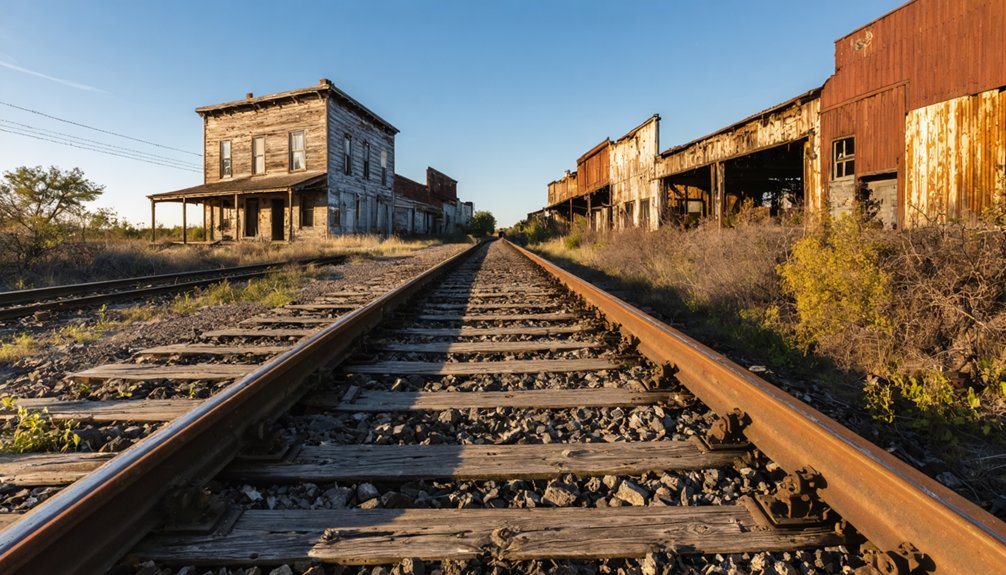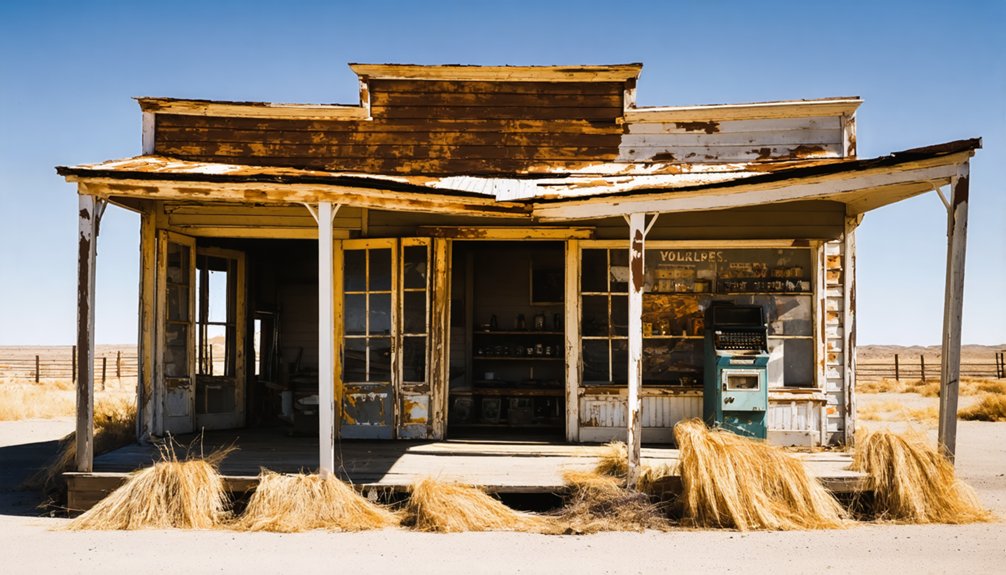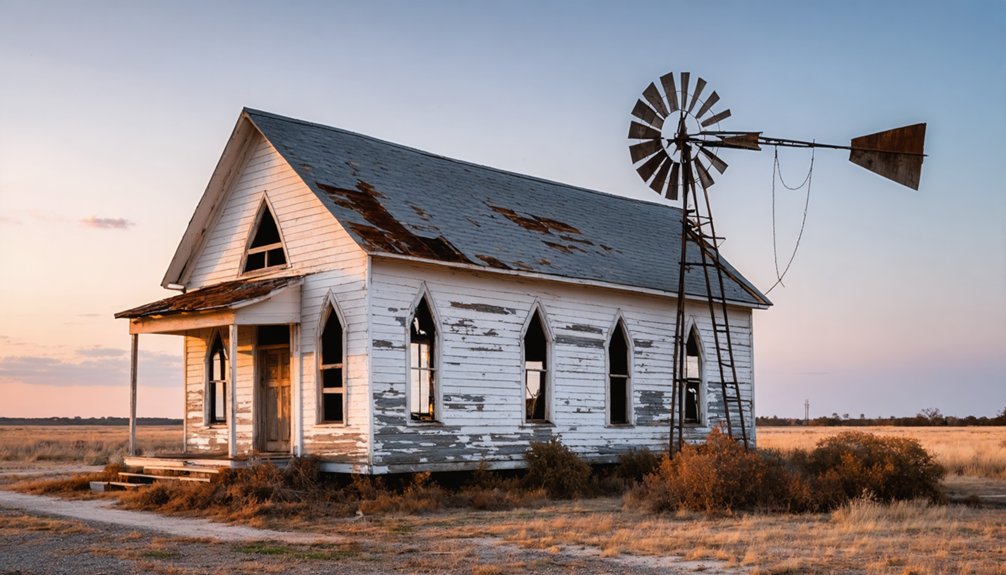You’ll find Upland’s ghost town remains in Upton County, Texas, where it briefly served as the county seat from 1910 to 1915. Founded in 1908 by Henry M. Halff, this pioneer settlement reached 501 residents and boasted a two-story courthouse, school, church, and newspaper. The town’s fortunes changed when the Orient Railroad bypassed it, and Rankin claimed the county seat. Environmental challenges and economic struggles transformed this once-promising settlement into one of Texas’s forgotten frontier stories.
Key Takeaways
- Upland was established in 1908 as Upton County’s first county seat but declined into a ghost town by 1918.
- Poor soil conditions, severe droughts, and water scarcity contributed significantly to the town’s eventual abandonment.
- The Orient Railroad’s decision to bypass Upland in 1911 led to businesses relocating to Rankin, accelerating the town’s decline.
- Loss of county seat status to Rankin in 1915 marked a crucial turning point in Upland’s transformation into a ghost town.
- Located at 2,688 feet elevation along the Butterfield Overland Mail route, Upland peaked at 501 residents before its abandonment.
The Rise of a West Texas Pioneer Settlement
While many West Texas settlements emerged during the early 1900s, Upland’s story began in 1908 when Henry M. Halff mapped out his vision for a new town.
You’ll find that early settlers, driven by pioneer spirit, quickly established essential community structures including a school, church, and post office.
Despite the harsh realities of West Texas’s arid climate, these determined folks tried their hand at farming and ranching.
Undaunted by West Texas’s unforgiving climate, early settlers pursued their agricultural dreams through both farming and ranching endeavors.
The settlement challenges were significant – poor soil quality and frequent droughts made agriculture nearly impossible.
Yet the proximity to the Kansas City, Mexico and Orient Railway, which reached nearby Rankin by 1911, offered hope for growth.
Most settlers adapted by focusing on livestock operations, taking advantage of the open range for cattle, horses, and sheep grazing.
Like their Scots-Irish ancestors who settled the Upland South, these pioneers showed remarkable resilience in the face of adversity.
Similar to the boom experienced in nearby communities during the 1920s oil boom, thousands of people flocked to the region seeking opportunities in petroleum production.
From Ranch Land to County Seat
As pioneers adapted to ranching life in early Upland, a significant change transformed the settlement’s identity in 1910. The town’s proclamation as Upton County’s first county seat marked the beginning of its brief but notable ascent.
You’d have found a bustling community where Henry M. Halff strategically sold land and built essential facilities, including a general store and hotel.
Upland’s significance grew with the construction of a stone courthouse and the establishment of the Upland Roundup newspaper. The town supported 501 residents across 105 ranches and farms, while its school system, opened in 1908, served the county’s growing population. Dr. George W. Elliott’s success in drilling for water helped establish early settlement viability.
With a post office managed by Edward B. Coatwright and various businesses emerging, Upland embodied the promise of a thriving West Texas administrative center. The town’s prosperity would be challenged by severe droughts and poor soil, leading to its eventual decline.
Early Life and Community Development
You’ll find Upland’s pioneering spirit reflected in its rapid transformation from ranch land to an organized community in 1908, when Henry M. Halff platted the townsite and began selling lots to enthusiastic settlers.
Edward B. Coatwright established the town’s first post office in 1907, marking an important milestone in Upland’s development as a frontier settlement.
The town’s first church provided spiritual guidance while serving as a social hub for the growing population of ranchers and merchants. Like many place name disambiguation, Upland’s history represents one of several significant settlements that shared this common frontier designation.
Upland’s dedication to education emerged quickly with the establishment of a school in October 1908, giving the children of early settlers access to formal learning on the Texas frontier.
Pioneer Settlement Origins
Located near the geographic center of Upton County, Upland emerged in 1908 when Henry M. Halff and his son platted the townsite, tapping into pioneer aspirations of West Texas settlers.
The town’s elevation of 2,688 feet provided a strategic position along the historic Butterfield Overland Mail route, which had served the region since 1859.
Despite settlement challenges like poor soil and limited water resources, Upland quickly attracted determined ranchers who’d been raising sheep and goats in the area since the 1890s.
Halff’s vision for growth included selling both business and residential lots while establishing essential infrastructure.
You’ll find that early development centered around a hotel, general store, and post office – which opened in 1907 under postmaster Edward B. Coatwright – creating the foundation for this budding community.
The town reached its peak with 100 residents before experiencing a gradual decline in population and economic activity.
Church and School Growth
When Upland’s first settlers established their community in 1908, they prioritized building both spiritual and educational foundations. The church and school quickly became the heart of local life, hosting community gatherings that strengthened the bonds between pioneer families.
- The town’s educational evolution began in October 1908, with classes starting immediately after the townsite’s establishment.
- By 1912, substantial school buildings reflected the community’s commitment to learning.
- Church services and school functions served as essential social anchors, helping residents cope with frontier challenges.
The town’s governance was centered around a two-story stone courthouse constructed to serve the growing population.
You’ll find that these institutions played significant roles in maintaining Upland’s stability during its early years, though both eventually succumbed to the town’s decline.
As population dwindled post-1910s, school enrollment dropped and buildings fell into disrepair, marking the community’s gradual shift toward ghost town status. Similar to the Great Depression era, local families were forced to relocate in search of work opportunities.
The Brief Golden Era: 1908-1915
You’ll find Upland’s golden era began in 1908 when businesses quickly sprouted around the newly platted townsite, establishing a vibrant commercial district near the Butterfield stage route.
The town’s designation as Upton County’s first seat in 1910 brought immediate construction of a two-story stone courthouse, cementing Upland’s status as a regional administrative center.
Like many other Texas communities such as Tennyson and Texana, Upland would eventually be classified as one of the state’s ghost towns.
This prosperity peaked between 1910 and 1915, with the town supporting multiple businesses, a school, a church, and the county’s first newspaper, the Upland Roundup.
Booming Business District Growth
Following Henry M. Halff’s town platting in 1908, Upland’s business district exploded with innovation and community resilience.
You’d have witnessed a remarkable transformation as commercial development surged, with Halff himself spearheading growth by constructing a hotel and general store while selling prime lots to enthusiastic investors.
The bustling business landscape featured:
- A thriving post office established by Edward B. Coatwright in 1907
- The county’s first newspaper, the Upland Roundup, launched by W. D. Riser in 1910
- Multiple retail shops and service providers catering to settlers’ needs
You’d have found a complete commercial hub taking shape, anchored by civic institutions like the church and elementary school.
The town’s central location in Upton County positioned it perfectly for trade, while strong investor confidence drove rapid commercial expansion through 1910.
County Courthouse Development
As Upland secured its position as Upton County’s first county seat on May 7, 1910, a commanding stone courthouse rose to symbolize the town’s newfound political prominence.
The courthouse’s significance extended beyond its administrative function – it represented the ambitious vision of town founders Henry M. Halff and his son, who’d worked tirelessly to establish Upland as a regional powerhouse.
You’ll find the courthouse’s story mirrors Upland’s own brief golden age. While the stone structure stood proudly as the heart of county government from 1910 to 1915, its fate changed dramatically after Rankin became the new county seat.
The once-proud architectural features fell into disrepair, and by 1960, you’d have found the building serving as little more than an occasional livestock shelter – a stark reminder of Upland’s fleeting glory days.
Population Peak Years
The construction of Upland’s courthouse coincided with the town’s remarkable population surge between 1908 and 1915. During this brief golden era, you’d have witnessed dramatic population shifts as both immigrants and regional settlers flocked to the area, drawn by promising economic changes.
The town’s transformation during these peak years reflected broader developments across Williamson County:
- Agricultural expansion and early industrial growth fueled the initial population boom
- The rise of automobile culture and petroleum discoveries around 1915 reshaped local demographics
- Regional urbanization patterns began drawing residents toward larger neighboring communities
While nearby towns like Jarrell grew to 500 residents by 1914, Upland’s peak period aligned with Texas’s rural communities experiencing significant changes as they shifted from farming-based economies to more diverse commercial activities.
Environmental Struggles and Economic Hurdles
While settlers initially hoped to establish a thriving community in Upland, Texas, severe environmental challenges and economic obstacles ultimately sealed the town’s fate.
You’d have found a settlement struggling against persistent water scarcity, where poor soil conditions made agricultural success nearly impossible.
Infrastructure deficiencies left the community isolated, with limited access to markets and essential services.
Environmental degradation took its toll as extreme weather events, including devastating droughts, further strained the town’s already fragile resources.
Despite showing community resilience, Upland couldn’t overcome the compounding effects of these hardships.
The town faced fierce resource competition from better-situated settlements, while ecological risks and minimal economic opportunities drove residents away.
Without adequate water or viable farming prospects, Upland’s dreams of prosperity gradually faded into dust.
The Impact of Railroad Decisions

Railroad routing decisions dealt the fatal blow to Upland’s aspirations in 1911, when the Orient Railroad constructed its line south of the settlement. The transportation consequences proved devastating for this fledgling Upton County seat, as commerce and population quickly shifted to towns with rail access.
A single railroad route spelled doom for Upland in 1911, as commerce followed the tracks to more fortunate towns.
- The town’s hotel physically relocated to Rankin by 1912
- The Upland Roundup newspaper abandoned the town within three years
- By 1915, Rankin had seized the county seat designation
You can trace the railroad impact through Upland’s swift decline – from a promising commercial hub to a virtual ghost town by 1918.
Without the essential rail connection that was originally planned from St. Louis to Chihuahua, Mexico, Upland couldn’t compete with neighboring settlements that enjoyed the economic benefits of railroad service.
A Town’s Gradual Disappearance
Following the railroad’s devastating impact, Upland’s decline unfolded through a perfect storm of challenges that sealed its fate.
You’ll find the town’s history marked by persistent droughts of the early 1910s that crippled farming efforts, while poor soil quality made sustaining livestock nearly impossible.
Despite the community’s resilience, the exodus began when many families sought better opportunities in Rankin.
Preserving Upland’s Historical Legacy

Despite its status as a ghost town, Upland’s historical legacy endures through dedicated preservation efforts that began in 1962 with local groups focusing on the abandoned courthouse.
Community engagement remains essential, with volunteers leading conservation initiatives and supporting infrastructure improvements to historical sites.
Key preservation challenges include:
- Limited funding and resources for restoration
- Remote location hindering sustained tourism
- Lack of formal municipal governance
You’ll find museums and heritage sites serving as custodians of local history, hosting educational tours and community events.
They’ve adapted by modernizing historical buildings with amenities like air conditioning while maintaining authenticity.
The town’s story lives on through interpretive programs, school field trips, and collaborations with travel media like “The Daytripper,” ensuring Upland’s cultural significance isn’t forgotten.
Lessons From a Lost Community
The rise and fall of Upland serves as a stark reminder of how seemingly promising frontier settlements could quickly fade into obscurity.
You’ll find that community resilience couldn’t overcome the harsh realities of poor soil, inadequate water sources, and devastating drought conditions that plagued early settlers. Despite initial signs of economic sustainability – with a courthouse, newspaper, school, and church – the town’s fate was sealed when the Orient Railroad bypassed it in 1911.
What’s particularly telling about Upland’s decline is how quickly infrastructure advantages can shift.
When transportation routes changed and the county seat moved to Rankin in 1915, the town’s isolation became insurmountable.
Frequently Asked Questions
Are There Any Ghost Stories or Legends Associated With Upland?
You won’t find documented haunted locations or spectral sightings in Upland’s history. While the abandoned courthouse and jail create an eerie atmosphere, there aren’t any verified supernatural legends or ghost stories.
What Happened to the Original Courthouse Building Materials?
Like a game of Minecraft, you’d find some courthouse materials relocated to Rankin by 1921, while other stone pieces remain as ruins on private land, defying historical preservation and courthouse renovation efforts.
How Did Native American Relations Affect Upland’s Development?
You’ll find that shifting tribal territories and limited cultural exchange stifled Upland’s growth, while unstable trade relations between settlers and native groups created an environment too volatile for sustained development.
Where Did Most of Upland’s Residents Relocate To?
You’ll find that in Upland’s history, most residents made their way to Rankin, Texas. They relocated there after 1911 as the town gained the railroad, county seat status, and their familiar institutions.
What Natural Resources, if Any, Were Discovered Near Upland?
You won’t find significant mineral deposits or reliable water sources near Upland. The area’s poor soil and severe lack of natural resources ultimately contributed to its abandonment and failure as a settlement.
References
- https://texasbob.com/travel/tbt_stiles.html
- https://en.wikipedia.org/wiki/Upland
- https://www.historictexas.net/city/upland-texas
- http://genealogytrails.com/tex/bigbend/upton/upland.html
- https://www.texasescapes.com/WestTexasTowns/Upland-Texas.htm
- https://texashistory.unt.edu/ark:/67531/metapth752794/m2/1/high_res_d/Between _the_Creeks_by_Gwen_Pettit_compiled_by_Melinda_Fisher.pdf
- https://en.wikipedia.org/wiki/Upland_South
- https://www.historictexas.net/city/pioneer-texas
- https://www.tshaonline.org/handbook/entries/upton-county
- https://www.texasbeyondhistory.net/forts/frontier.html



